16 Chef-Approved Ways To Upgrade Homemade Salad Dressing
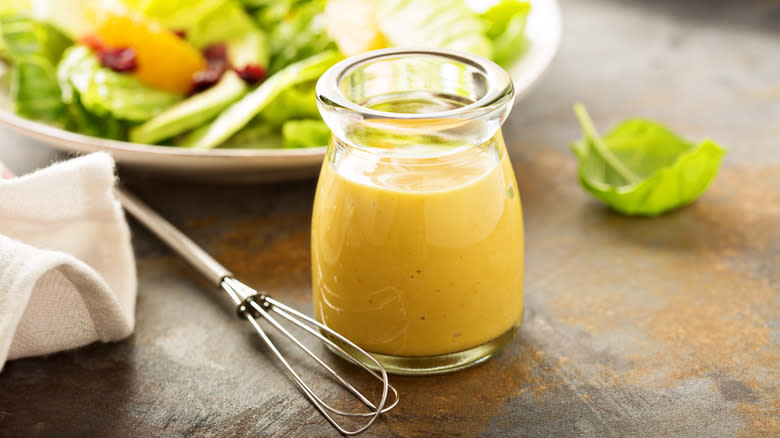
Salads are an easy and delicious way to eat more vegetables. And adding dressing to your salad can help elevate your greens into something magical, with just a few simple ingredients emulsified to creamy perfection. While you can purchase salad dressings from the grocery store, many of these are loaded with unidentifiable ingredients that may be unhealthy and lacking in flavor. The better route to go is to make your own homemade salad dressing. And, once you have the basics mastered, you will want to discover the ways you can transform everyday salad dressing into something truly special.
In my nearly 18 years as a professional chef, I always made my own salad dressing. From blue cheese to green goddess, every dressing that touched a leaf of lettuce in my kitchen was adorned with homemade ingredients designed to showcase those greens. In this story, I'm divulging my chef-approved trade secrets regarding ways to upgrade your next batch of homemade salad dressing and turn the salad into the highlight of your meal.
Read more: French Cooking Tricks You Need In Your Life
Change Up The Acid

Acids like vinegar or lemon juice, are often used as the foundation for your homemade salad dressings. These help to brighten a dressing's flavor, and balance elements that are sweet, bitter, salty, and rich in umami. That said, there are plenty of different kinds of acids that you should incorporate into your next dressing. Choosing the right ones will confer more complexity and playfulness to your recipe.
First consider citrus juices, like orange, lime, or grapefruit juice. These have varying degrees of sweetness and tartness that can be well-suited to the ingredients you are using in your salad. There are also a number of flavored vinegars that you can purchase, such as raspberry balsamic, champagne, and tarragon-infused vinegar. These are especially delicious and fun. Lastly, take a hint from celebrity chef Curtis Stone and start adding the brine from pickles, olives, and sauerkraut to your dressing. This will contribute a nuanced flavor.
Get Playful With Different Oils
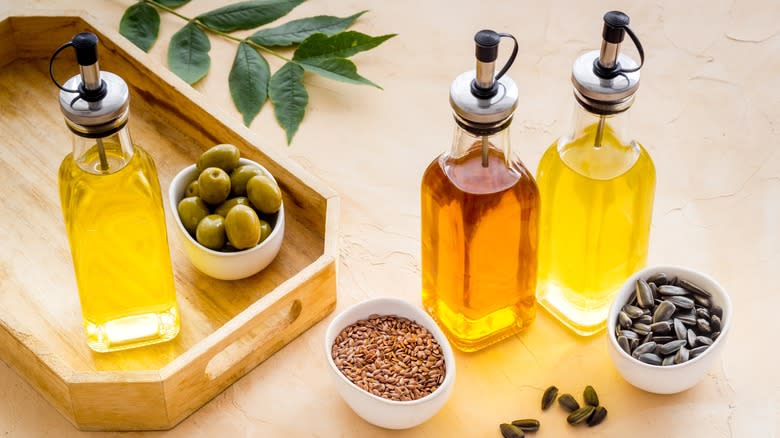
The best oils to use in your homemade salad dressing are those that are delicate and neutral in flavor, as these allow all the ingredients to shine. My go-to is typically a light olive oil. That said, I am not opposed to switching things up and going bolder -- as long as the oil you choose is well-balanced with the other components of my salad dressing.
One great option for switching things up is to opt for a flavor-infused olive oil (like a savory garlic or truffle-infused oil) or a sweeter alternative (such as those made with blood orange or Meyer lemon). Another superior alternative is walnut oil, which has a delicate nuttiness that is compatible with sweet and savory ingredients alike. Lastly, try making your own tadka -- a mixture of heated fats and spices -- for a full-flavored, yet nuanced oil addition. I recommend starting with a combination of ghee and sesame oil for your chosen fats. Then, infusing these fats with dried chilis, cumin seeds, and garlic. Just be sure not to burn the spices, and allow the tadka to cool completely before straining it and using the flavored fat in your salad dressing.
Go Bold With Seasoning Mixes
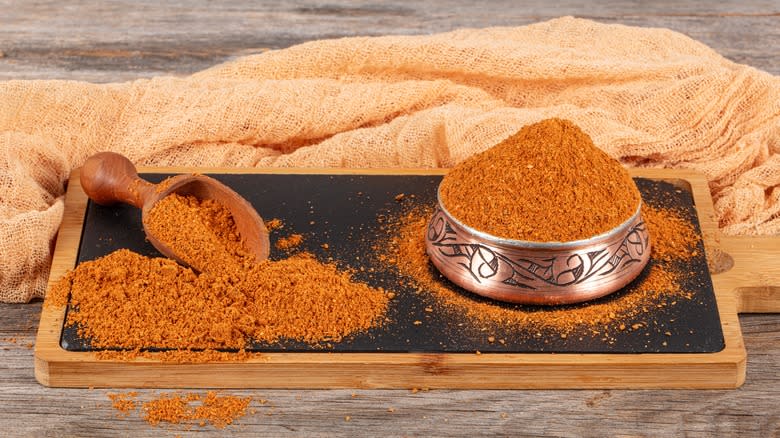
Sometimes, salt and pepper are the only seasonings needed in a salad dressing -- especially if plenty of other complex flavors are added in the form of non-seasoning ingredients. That said, in my experience, adding seasonings of various kinds can turn a relatively mundane dressing into something quite extraordinary. There are a number of spice mixes out there that are dynamite. Just be sure to adjust the amount of salt you add to your recipe to accommodate the sodium content of whatever seasoning blend you use.
Blends like curry powder, ras el hanout, or za'atar (which is rife with lemony sumac that pairs beautifully with citrus elements) are always great. Taco seasoning, Cajun spice mix, or everything bagel flavoring are also useful when used in moderation. Lastly, classic Hidden Valley ranch powder can be incorporated into any type of dressing for a punch of flavor. The key is adding a little at a time until you achieve the desired taste.
Add Some Booze

A splash of wine can also be a useful ingredient in salad dressing. The intent here is not to turn your salad into an intoxicating menu item, but rather to take advantage of the complexities in flavor that are achieved when alcohol is fermented. While you can use red wine, I generally opt for a dry, acidic white wine (like a pinot grigio), or a fortified wine (like a dry vermouth or sherry).
Though wine may be my first choice, there are plenty of other types of alcohol that can be used to confer a distinctive flavor. Some of these include a caramel-forward bourbon, a slightly sweet vodka, or a citrusy reposado tequila. You can also supplement your salad dressing by adding liqueurs like Campari that are typically reserved for cocktails. Liqueurs tend to be more viscous and sweeter, giving your salad dressing a rich texture and amplified flavor. Keep in mind that you may not want to add alcohol to your salad dressing if you are serving children, expectant mothers, or those who are abstaining.
Sweeten It Up

Acidity is necessary in a salad dressing, but sometimes it can become a bit overwhelming. The best way to temper the acidity in salad dressing -- without completely neutralizing it -- is to add something sweet. Honey, maple syrup, agave, or sugar are all appropriate when used in moderation. The key is adding a little at a time so that you achieve the perfect balance, depending on your acid of choice and any other ingredients you are incorporating into the recipe, such as aromatics or seasonings.
But, don't limit yourself to standard sweeteners. There are other options you can use to achieve that flavor balance. For example, if you happen to have a touch of leftover jam, jelly, or marmalade, infuse that into your salad dressing. And, if you really want to get crafty with your salad dressing, bust out a chocolate bar. Dark, milk, and even white chocolate can create an elegant juxtaposition of flavors in a salad dressing.
Don't Skip The Aromatics

Aromatics (like garlic, onions, green onions, shallots, or fresh ginger) are the base of many recipes. They're often key players in soups, stews, and stir-fries. They can also infuse salad dressings with brightness and complexity. Whichever you choose to add, use some discretion. Alliums such as shallots will confer a slightly less assertive flavor than others.
When adding aromatics, you can slice, chop, mince, or purée them using a microplane before adding them to your favorite dressing. Alternately, try sautéing, caramelizing, or roasting them, for a more subtle and sweet flavor. If you insist on using raw onions, you can temper them by soaking them in an ice water and baking soda bath for a few minutes. To obtain the flavor of raw garlic without scaring away your neighbors with your breath, reserve half a clove of garlic and rub it around the bowl in which you are dressing your salad, rather than adding it directly to your vinaigrette.
Spice Things Up With Condiments

Condiments are often an afterthought when it comes to cooking. Most of us use them to garnish a dish after it has been prepared, rather than incorporating them into the recipe along the way. It's time that we reimagine the possibilities when it comes to using condiments as fundamental ingredients in recipes, including salad dressings. While some condiments are spicy or salty, many of them are also rife with rich, umami elements that can completely transform salad dressing, giving it a more savory, satiating quality.
Hot sauce might be what your salad dressing is missing. Ingredients like gochujang, harissa, or sriracha offer heat, acidity, aromatics, and umami flavors. When you are assembling creamy dressings, particularly ones with strong flavors, like blue cheese or green goddess, Worcestershire sauce is a dynamic addition, punctuated by a kick of salt and umami richness conferred by its secret ingredient: anchovies. Lastly, soy sauce can add a salty kick and umami bite in Asian-inspired salad dressings.
Emulsify With Different Types Of Mustard
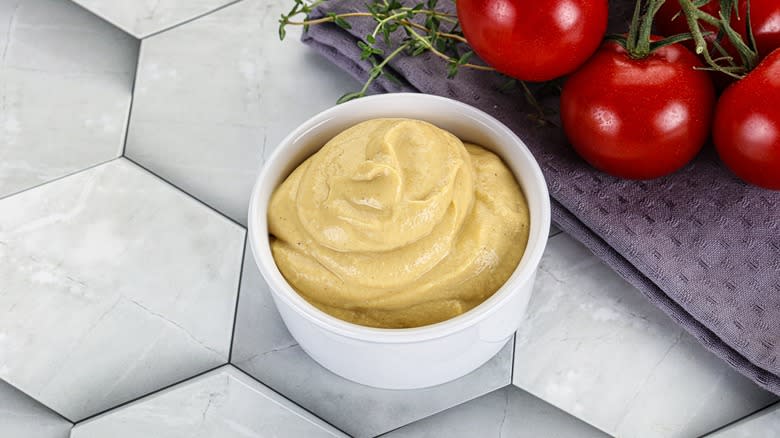
At its core, a salad dressing is an emulsification -- or a homogeneous blend formed from two immiscible or incompatible ingredients (like oil and vinegar). Most emulsifications require a surfactant to help bind the oil and vinegar together. The surfactant most frequently used is mustard. Not only does mustard work beautifully to marry oil and vinegar, it enriches the flavor of salad dressing with a hint of lively pepperiness.
While there are a number of mustards you don't want to use for salad dressing -- including plain yellow mustard and those with a coarse grind -- there are plenty of others that can amplify the flavor of your vinaigrette, while helping glue the ingredients together. Dijon is my usual go-to, but honey, horseradish, and cranberry mustards are all great options for creating dressings with a complex flavor and consistent texture. You can also combine mustards for even more nuance, just be sure to adjust the amounts so that you don't overpower the other ingredients in the dressing.
Think Outside The Milk Carton To Make It Creamy
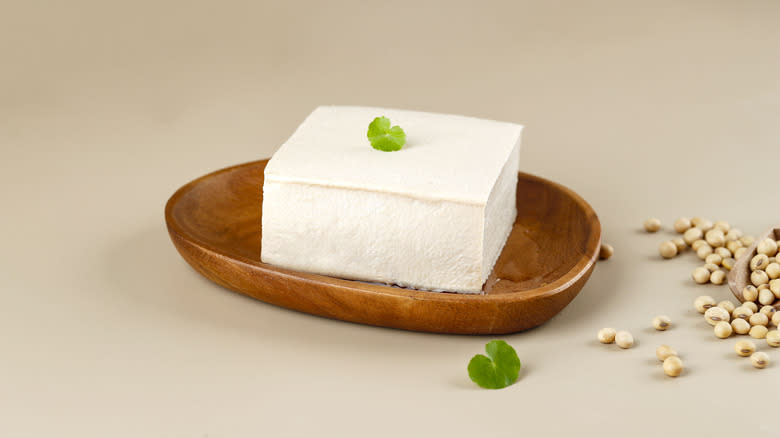
Creamy salad dressings are the perfect accompaniment to more robust greens, like romaine and iceberg, and as a dip for fresh vegetables or buffalo wings. Many of these use milk, buttermilk, or heavy cream to achieve their characteristic texture. While there is nothing wrong with this, plenty of other options exist that can accommodate different palates and dietary needs.
Among my favorite non-dairy options are silken tofu, avocado, and nut butter. These will require a food processor or blender to achieve a smooth texture. If you don't mind dairy, cottage cheese and Greek yogurt are high-protein, probiotic-rich substitutions that can really amp up the nutritional value of your salad dressing. Cream cheese can also improve your salad dressing, as it provides the tang of buttermilk with the richness of mayonnaise. Lastly, if you happen to have leftover French onion or vegetable dip from that party tray you ordered for a special occasion, you can easily repurpose them by transforming your favorite dip into a luscious salad dressing.
Brighten Things Up With Fresh Herbs

If fresh herbs and salad dressing made you think of a classic green goddess dressing, you are on the right track. This verdant, creamy, umami-rich salad topper is packed with the aroma and flavors of assorted herbs, giving your greens a much needed boost. And herbs of all kinds can easily be added to any salad dressing to elevate it. Fresh dill, tarragon, basil, and parsley are favorites, but virtually any herb can do the trick. Perhaps the only caveat to this is rosemary. It can be added to dressing, but not with abandon. This herb should be finely minced first, due to its woody texture.
If you happen to have a batch on hand, you can impart some herbaceous zing into your salad dressing by adding a scoop of pesto to it. The combination of basil, parmesan cheese, garlic, pine nuts, and olive oil serves as a marvelous base for a salad dressing, be it a vinaigrette or a creamy ranch.
Go Middle Eastern With Tahini Or Hummus
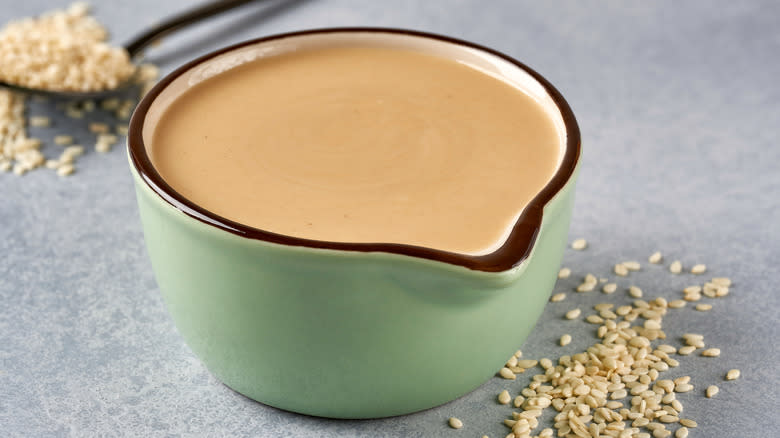
When you think of dishes that epitomize Middle Eastern cuisines, chances are falafel with tahini sauce or hummus comes to mind. Indeed, tahini (a thick sesame paste) is a staple in many recipes, including dips like hummus and salad dressings. Its creamy texture acts as an emulsifier in salad dressings, while its rich, nutty flavor confers a distinctive taste.
Plain tahini can be added as-is to salad dressings rich with the tang of citrus juices. Just remember to stir the tahini well before incorporating it. Like natural peanut butter, it has a tendency to separate in the jar. If you happen to have a leftover container of hummus -- which contains tahini paste blended together with protein-rich chickpeas -- whip some together with a bit of mustard, red wine vinegar, and sesame oil for a delightful, quick dressing that can jazz up any kind of salad.
Add Umami With Miso
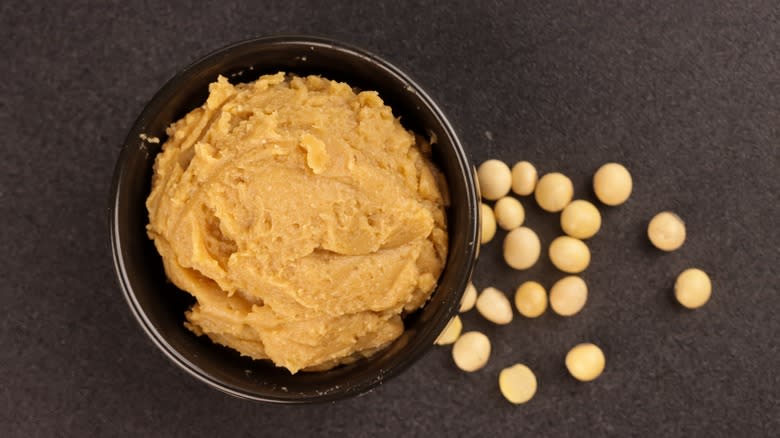
If you are searching for an ingredient that can boost the umami profile of your salad dressing and lend a hint of Asian flair, look no further than miso. Miso is a fermented soybean paste commonly associated with Japanese cuisine. Though it is typically used as a condiment to accentuate the savoriness of a dish, when layered as an ingredient in a recipe, it provides a complexity and funkiness that cannot be matched.
The key to using miso in salad dressing is to understand its different kinds. Though there are many different types of miso, the ones you will most commonly find are white (shiro miso) and red (aka miso). The primary difference between the two are their lengths of fermentation, which is relatively short for the former and much longer for the latter. Because of its shorter fermentation period, white miso is more subtle and sweet in flavor, making it the preferred choice for infusing into salad dressing recipes.
Give It Festive Fall Flair With Pumpkin Purée
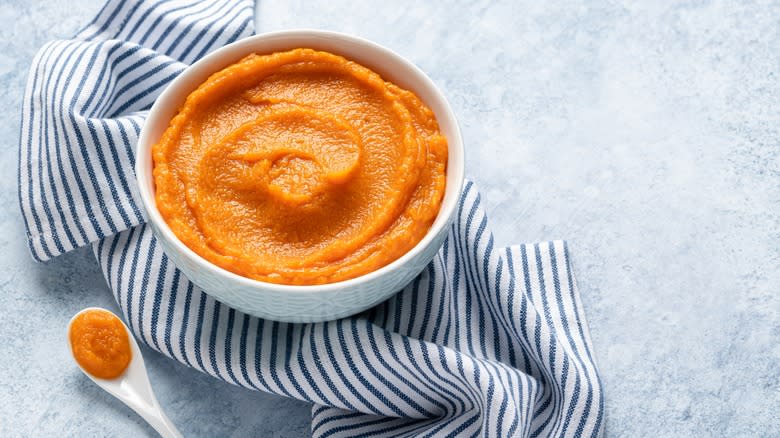
If you have ever found yourself with a partially used can of leftover pumpkin purée, add it to salad dressing. Its creamy texture makes it a natural emulsifier in dressing, while its slightly sweet flavor will naturally counterbalance the acidity. As a bonus, it is a nutrient-dense food that can make a healthy salad even better for you. Just make sure you use plain pumpkin purée and not pumpkin pie filling, which is seasoned with spices and contains sugar.
When using pumpkin purée, you may want to consider whipping up a Thanksgiving-inspired salad dressing, complete with cranberry mustard, maple syrup, walnut oil, and a hint of apple cider or champagne vinegar. This would be perfect atop mixed greens garnished with candied pecans or walnuts, dried cranberries, and goat cheese. Just be sure to pop this dressing into a blender or food processor to fully incorporate the pumpkin purée until it is smooth.
Make It Rich With A Soft-Boiled Egg

When it comes to creating a creamy salad dressing, recipes will often turn to ingredients like mayonnaise, buttermilk, or sour cream to obtain the perfect texture. If you happen to be looking for a dairy-free alternative that is a bit lighter, yet equally effective in giving salad dressing a luscious texture, look no further than the egg. A puréed, soft-boiled egg is the perfect swap for a non-dairy salad dressing, thanks to its rich, slightly runny yolk.
The key is knowing how to properly soft-boil an egg. My favorite method is to bring a saucepan of water to a boil and gently lower the eggs into it. Allow them to cook for five minutes before draining the hot water and covering the eggs in cold water. Once the eggs are completely cool, they can be peeled and either used immediately or refrigerated for use within a couple of days. Just be sure to store them in an airtight container to prevent them from absorbing other aromas from the refrigerator.
Add Tang With Leftover Frozen Fruit
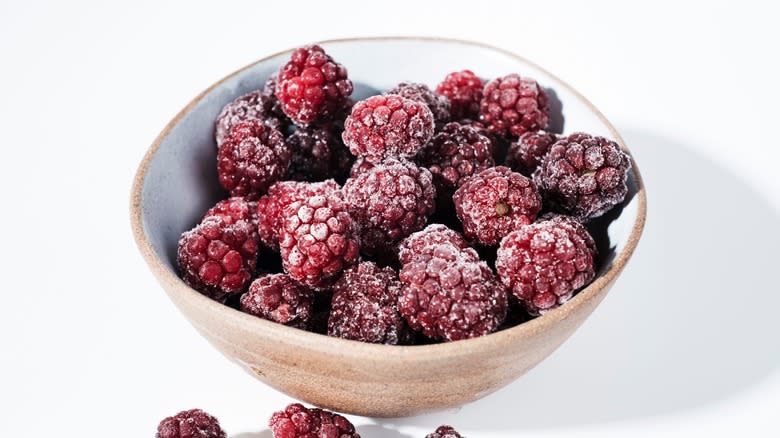
We all know that frozen fruit is great in a smoothie, but if you happen to have some leftover frozen berries, try adding them to your next salad dressing recipe. Frozen fruit is known to be just as nutritious and flavorful as fresh fruit. What does suffer somewhat is its texture, which can become pulpy as the cellular structure of the fruit degrades in the freezer. While this may be less desirable for out-of-hand eating, it is ideal for making salad dressing, where the goal is to fully emulsify all the ingredients into a smooth texture.
The key to using frozen fruit is to thaw it in the refrigerator before incorporating it into your dressing. If you notice any leftover juices from the thawed fruit, add this to the dressing for flavor, but do note that you may need to amend the amount of oil you use to prevent the dressing from becoming too watery.
Enhance The Flavor With Vanilla Extract
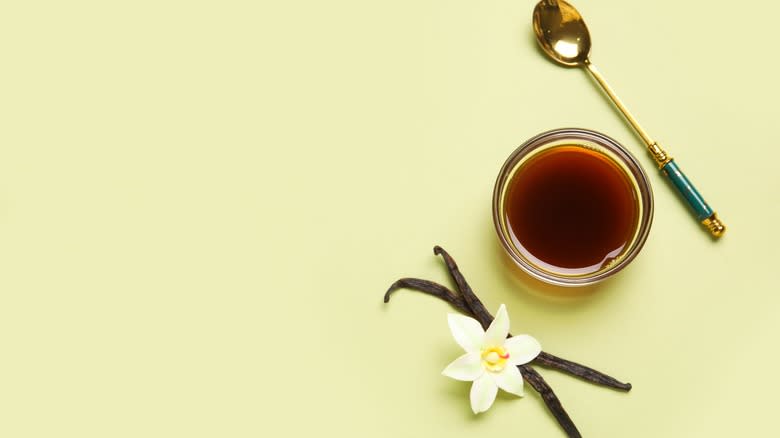
While vanilla extract may be more well-known for its enhancement of desserts and baked goods, it is a versatile ingredient that has its place in savory applications, including as an ingredient in salad dressings. Though you may think the vanilla will overpower the other components of your salad dressing, this is hardly the case if it is used in moderation. Its role in recipes is to amplify sweet ingredients while tempering bitter and acidic ones. Vanilla harmonizes all of the ingredients in a salad dressing, allowing them to perfectly meld together.
Among the most ideal accompaniments to vanilla in salad dressing recipes are maple syrup and white chocolate. This dynamic trio is a match made in heaven when paired with bitter greens, like arugula, tangy goat cheese, tart blueberries, and rich macadamia nuts. It can also be a game changer when assembling a bright tomato vinaigrette, where it naturally balances out the acidity of the fruit.
Read the original article on The Daily Meal.

 Yahoo Lifestyle
Yahoo Lifestyle 
